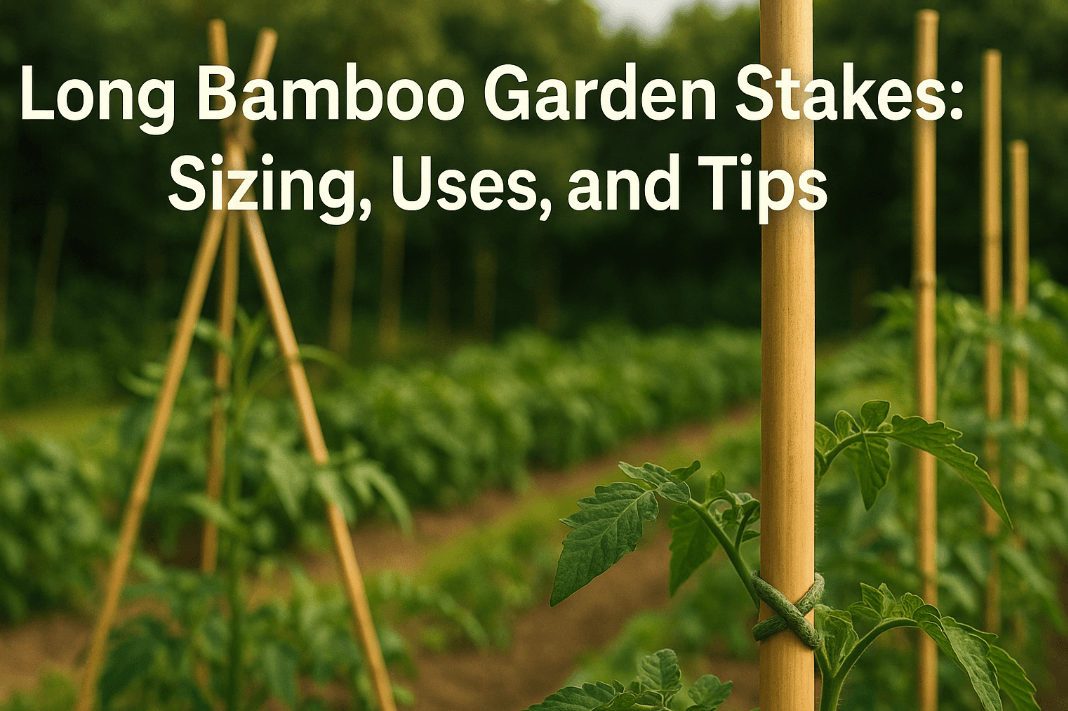Long Bamboo Garden Stakes: Sizing, Uses, and Tips
Long bamboo garden stakes are the quiet workhorses of tall crops, roses, young trees, and wind-exposed beds. Proper sizing and installation reduce blowdowns, stem damage, and mid-season re-tying. This guide shows you how to choose length and diameter, install for real stability, and plan quantities like a pro.
Context for trade buyers: Wellco Wholesale serves growers, landscapers, and contractors with bulk garden and farm supplies, including custom bundling and pallet consolidation to keep freight simple and predictable.

About the editor
Edited by a horticulture content lead who has trained installation crews for commercial tomato and bean blocks across coastal and inland sites; lessons below reflect field practices cross-checked with land-grant extension guidance.
Quick Selector: crop → length/diameter/tie
| Crop / use | Typical stake length | Recommended diameter | Go-to tie |
|---|---|---|---|
| Indeterminate tomatoes | 6–8 ft (1.8–2.4 m) | 14–18 mm | Figure-eight twine or clips; start ties once 10–12 in tall. |
| Runner/pole beans, cucumbers | 8–10 ft (2.4–3.0 m) | 16–20 mm | Teepee/tripod or ridge line with soft ties. |
| Roses & tall ornamentals | 5–7 ft (1.5–2.1 m) | 12–16 mm | Soft ties; lower tie plus mid-canopy tie. |
| Young trees / espaliers (training) | 8–12 ft (2.4–3.6 m) | 18–24+ mm | Two soft ties; remove when stable. extension.umn.edu |
Field note: After a coastal storm season, our crews cut re-staking by switching tomatoes from 12–14 mm to 16–18 mm and adding a mid-canopy tie—less flex, fewer snapped stems.
Choosing length, diameter & wall
Match plant & load
Use expected plant height, fruit weight, and site wind as your baseline. When in doubt, size for the worst day, not the best.
Diameter & wall density
-
14–16 mm is common for moderate tomatoes in sheltered beds; 16–18 mm for wind or heavy fruit.
-
18–24+ mm suits tree training, perimeter runs, and long ridge lines.
Minimal taper and denser walls resist flex and snap; check node spacing and culm roundness during QC.
Species & finish
-
Tonkin is valued for straightness and dense nodes; Moso is abundant and sturdy.
-
Natural finish grips ties well; flame-polish reduces splinters; varnish/seal slows moisture uptake but can chip—inspect wear points.
Durable in the weather: storage, service life & safety
Expected service life
Outdoors, plan for 1–3 seasons depending on climate, soil moisture, and storage habits. End caps, sleeves, and sealing cut ends can slow fraying.
Storage & handling
Keep bundles dry, elevated, ventilated. Rotate to prevent flat spots. Use gloves/eye protection when cutting. Stake caps or a blunted tip reduce puncture hazards near paths.
Safety & compliance
-
Keep pathways clear; mark guy lines.
-
Use soft ties to avoid stem girdling.
-
For tree training, stake only as needed and remove once stable to encourage trunk strength. extension.umn.edu
Installation methods that actually hold
Single stake & figure-eight
Drive stakes at least ~12 in (30 cm) into the soil near transplanting; go deeper (up to ~18 in) for longer stakes or windy beds. Begin tying around 10–12 in plant height and add ties as the canopy rises.
Tie cadence: place new ties every 12–18 in of vertical growth on rows using string/wire guides; for single-stake systems, more frequent ties (≈8–12 in) help control sway.
Tripod/teepee for climbers
Form a stable apex and lash securely; distribute bases evenly to spread load and resist gusts. (Use protective sleeves where lines contact bamboo to prevent abrasion.)
A-frame & ridge line trellis
Anchor end bays first, tension the ridge line, and sleeve contact points so lines don’t cut into culms.
Mixed materials
On very windy sites, pair bamboo with ground anchors or light guy lines at ends to control sway.
Cost, ROI & alternatives
-
Think cost per season, not per piece (e.g., a $2.40 stake lasting three seasons costs ~$0.80/season).
-
A small diameter step-up often pays for itself in fewer mid-season failures.
Alternatives
-
Galvanized steel: longest life, higher cost, hotter in sun.
-
Fiberglass rods: consistent diameter, non-corrosive; ties may slip if too smooth.
-
Timber stakes: strong but heavy; splitting risk.
Bamboo wins where weight, renewability, and cost matter.
Specs & receiving: a pro buyer’s checklist
Key specs table
| Spec | Typical options / checks |
|---|---|
| Lengths | 5–12 ft (150–360 cm) |
| Diameter | 10–30+ mm; note taper tolerance |
| Finish | Natural / flame-polished / sealed |
| Straightness | Minimal bow; even node spacing |
| Moisture | Dry to the touch; no mildew odor |
| Bundle/pallet | Common bundles 25/50/100; verify pallet ID & label |
QC on arrival
Open a bundle and spot-check: diameter at 3 points, split rate, tip condition, mildew, node integrity. Label the QC result on the pallet for FIFO rotation.
Bulk sourcing tips
Ask suppliers about lead times, mixed-length pallets, and season-to-season repeatability.
Value add: Wellco Wholesale can consolidate garden, farm, hotel, and supermarket supplies on the same shipment—fewer vendors, fewer freight touches, simpler receiving.
How many stakes do you need? (fast planner)
Formula: Stakes = (Row length ÷ Plant spacing) × Stakes per plant
Examples for a 10 m row:
-
Tomatoes @ 50 cm spacing, 1 stake/plant → 20 stakes
-
Pole beans @ 30 cm spacing, shared teepees (~0.5 stake/plant) → ~17 stakes
-
Cucumbers @ 45 cm spacing, 1 stake/plant → 22 stakes
Add 5–10% buffer for breakage and late plantings.
Sustainability & end-of-life
Bamboo is a rapidly renewable grass. Reuse older stakes for lighter duties, craft applications, or chipping for paths where permitted. Avoid composting coated pieces; follow local rules.
Soft COI note
This guide is informational. Wellco Wholesale supplies long bamboo garden stakes and related goods, but recommendations here prioritize safe, effective practice over any single product.
Conclusion
Pick length for plant height and wind, choose a diameter that resists flex, embed stakes deep enough for leverage, and add ties as canopies climb. Store stakes dry and ventilated to stretch each piece over multiple seasons. Trade buyers and serious gardeners save time and costs by planning quantities, QC, and freight up front—if you’d like a consolidated quote, Wellco Wholesale can bundle categories to streamline purchasing.
Sources consulted
Key installation practices and tie/spacing recommendations were cross-checked against land-grant and university extension resources. See inline citations for details.
-
University of Maryland Extension (tomato staking lengths, embed guidance).
-
Rutgers NJAES (stake placement and reinforcement practices).
-
University of Georgia Extension (tie cadence and timing).
-
University of Minnesota Extension (tree staking “only as needed”). extension.umn.edu
Frequently Asked Questions
1) How long do long bamboo garden stakes typically last outdoors?
Plan for 1–3 seasons depending on climate, soil moisture, and storage. Dry, elevated storage and capping cut ends extend life.
2) Which is better for stakes—Tonkin or Moso?
Both work well. Tonkin is known for straightness and node density; Moso is widely available and sturdy. Choose based on straightness grade, diameter, and finish rather than species alone.
3) What’s the minimum embed depth for an 8-ft stake?
University guidance commonly recommends ~12 inches into the soil; go deeper on windy sites or with longer stakes (e.g., up to ~18 inches) and add more ties up the canopy.
4) When should I remove training stakes for young trees?
Stake only if necessary and remove after the tree is stable to encourage trunk strength.
5) Can I mix bamboo with other hardware for windy plots?
Yes—use bamboo for plant ties, but combine with ground anchors or guy lines at row ends to limit sway and reduce mid-season failures.

